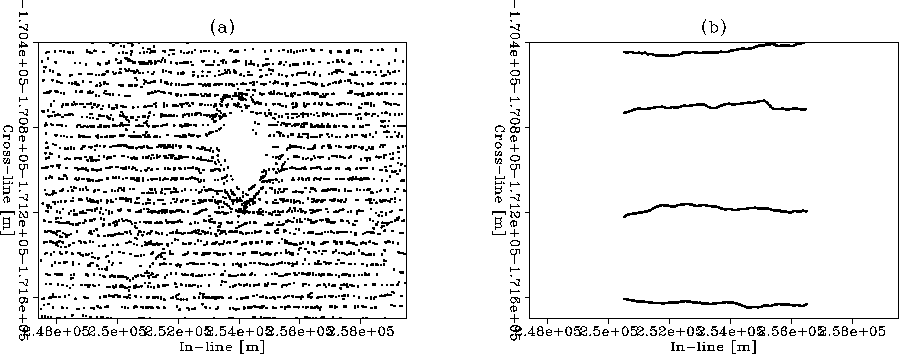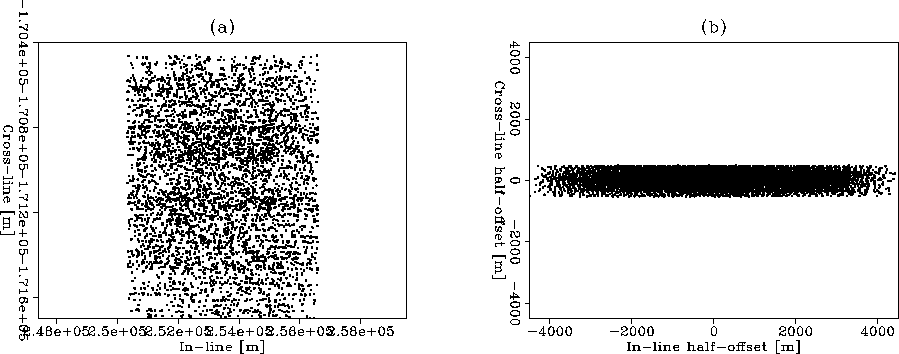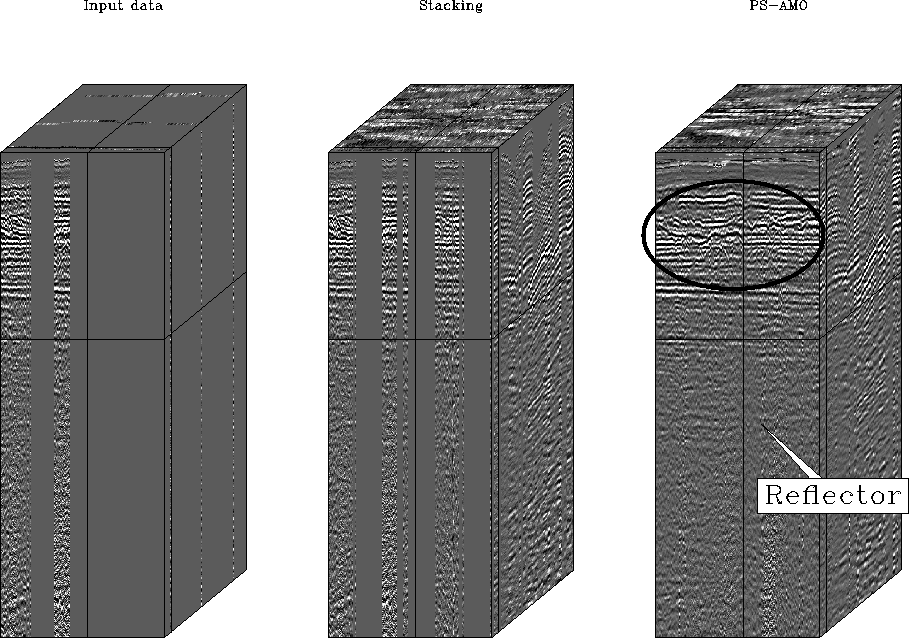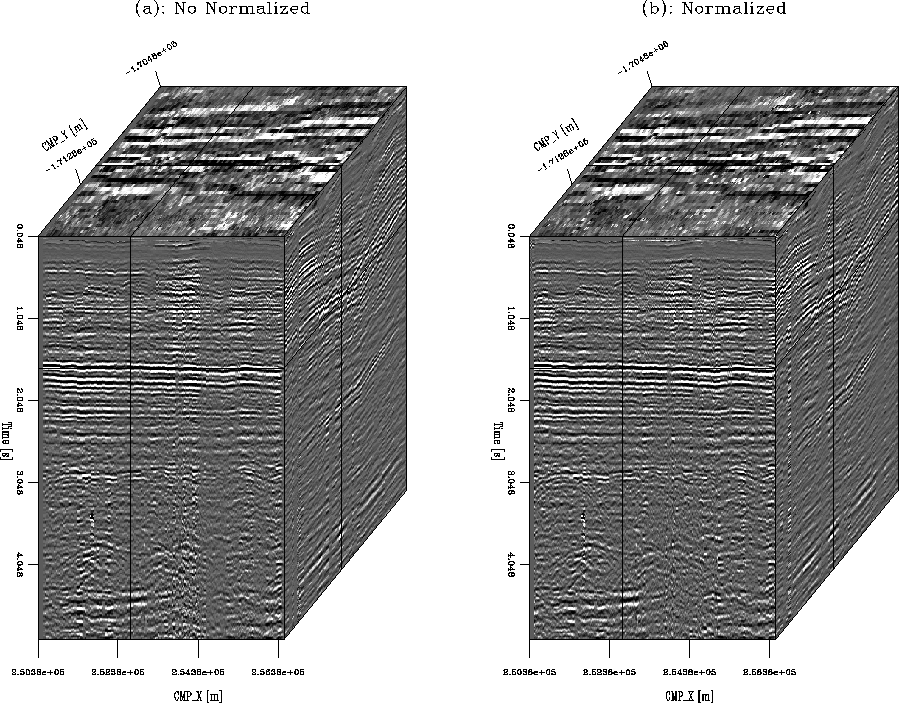




Next: Conclusions
Up: Rosales and Clapp: PS-AMO
Previous: Parallel implementation
We apply PS-AMO regularization to a portion
of a real OBS data set recorded above the Alba oil field.
The Alba oil field is located in the UK North Sea and
elongates along a NW-SE axis. The oil reservoir is 9 km
long, 1.5 km wide, and up to
90 m thick at a depth of 1,900 m subsea Newton and Flanagan (1993).
The 3-D OBS data set has been already preprocessed and
separated into a PP and a PS section.
This paper focus on the PS section only.
The subset of the data set consists of 250 inline CMPs,
50 crossline CMPs, 200 inline half-offset, and 40
crossline half-offset.
Figure ![[*]](http://sepwww.stanford.edu/latex2html/cross_ref_motif.gif) presents the spatial distribution
for the shots on the left, and receivers on the right.
Observe the gap in the shot
distribution due to the platform.
Additionally, Figure
presents the spatial distribution
for the shots on the left, and receivers on the right.
Observe the gap in the shot
distribution due to the platform.
Additionally, Figure ![[*]](http://sepwww.stanford.edu/latex2html/cross_ref_motif.gif) shows the distribution of the CMPs on the
left, and the offsets on the right. Note that
the main goal of this experiment is to collapse
the crossline offset into zero crossline offset.
Figure
shows the distribution of the CMPs on the
left, and the offsets on the right. Note that
the main goal of this experiment is to collapse
the crossline offset into zero crossline offset.
Figure ![[*]](http://sepwww.stanford.edu/latex2html/cross_ref_motif.gif) shows the data, for a particular
inline offset, at zero crossline offset.
Observe the sparsity of the data and
the small number of live traces.
shows the data, for a particular
inline offset, at zero crossline offset.
Observe the sparsity of the data and
the small number of live traces.
shot-rec
Figure 2 Source (a) and
receiver (b) distribution for the fraction of OBS data set
in study.




 cmp-off
cmp-off
Figure 3 CMPs (a) and
half-offset (b) distribution for the fraction of OBS data set
in study.





data
Figure 4 Real data
problem, data for zero crossline offset, the
missing data is obvious.
|
|  |





Figure ![[*]](http://sepwww.stanford.edu/latex2html/cross_ref_motif.gif) presents the main
result of this paper. It compares the real data
at zero crossline offset, the result of
pure stacking all the crossline offsets, and
the result of partial stacking the crossline offsets
with the PS-AMO operator. The sections for all the
cubes are taken at the same position. Note that
by just stacking there are still holes in the
data. This is not the case after running
partial stacking with the PS-AMO operator.
presents the main
result of this paper. It compares the real data
at zero crossline offset, the result of
pure stacking all the crossline offsets, and
the result of partial stacking the crossline offsets
with the PS-AMO operator. The sections for all the
cubes are taken at the same position. Note that
by just stacking there are still holes in the
data. This is not the case after running
partial stacking with the PS-AMO operator.
data-psamo-comp
Figure 5 Result of
partial stacking with PS-AMO.
(a) Real data at zero crossline offset.
(b) Result of simple stacking all the crossline offsets
into zero crossline offset. (c) Result of running
PS-AMO to collide all the crossline offsets into
zero crossline offset.





Additionally, Figure ![[*]](http://sepwww.stanford.edu/latex2html/cross_ref_motif.gif) presents the partial stacking with PS-AMO
with and without the normalization.
Note that by approximating the
Hessian of the PS-AMO transformation using
equation 12, we are
able to balance the energy of the traces
after normalization.
presents the partial stacking with PS-AMO
with and without the normalization.
Note that by approximating the
Hessian of the PS-AMO transformation using
equation 12, we are
able to balance the energy of the traces
after normalization.
psamo-unor-nor
Figure 6 Result of
PS-AMO reduction. (a) Unnormalized PS-AMO reduction.
(b) Normalized PS-AMO reduction.










Next: Conclusions
Up: Rosales and Clapp: PS-AMO
Previous: Parallel implementation
Stanford Exploration Project
4/5/2006
![[*]](http://sepwww.stanford.edu/latex2html/cross_ref_motif.gif) presents the spatial distribution
for the shots on the left, and receivers on the right.
Observe the gap in the shot
distribution due to the platform.
Additionally, Figure
presents the spatial distribution
for the shots on the left, and receivers on the right.
Observe the gap in the shot
distribution due to the platform.
Additionally, Figure ![[*]](http://sepwww.stanford.edu/latex2html/cross_ref_motif.gif) shows the distribution of the CMPs on the
left, and the offsets on the right. Note that
the main goal of this experiment is to collapse
the crossline offset into zero crossline offset.
Figure
shows the distribution of the CMPs on the
left, and the offsets on the right. Note that
the main goal of this experiment is to collapse
the crossline offset into zero crossline offset.
Figure ![[*]](http://sepwww.stanford.edu/latex2html/cross_ref_motif.gif) shows the data, for a particular
inline offset, at zero crossline offset.
Observe the sparsity of the data and
the small number of live traces.
shows the data, for a particular
inline offset, at zero crossline offset.
Observe the sparsity of the data and
the small number of live traces.




